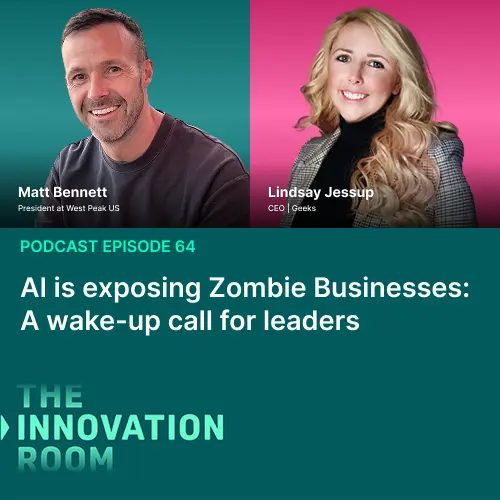
Psychologically enhanced AI agents: The next frontier in human-centric AI
AI agents are evolving fast, but their limitations are clear. They can execute tasks and process information at scale, yet often fall short when it comes to emotional depth, consistency of behaviour, and the ability to build lasting trust with users. For businesses, this creates a barrier: efficiency is gained, but genuine engagement and adoption remain out of reach.
Psychologically enhanced AI agents change that equation. By blending cognitive intelligence with psychological models of personality and affect, they create interactions that feel coherent, human-centric, and reliable. This shift matters for leaders shaping their AI adoption strategy, it’s not about replacing people, but about creating agents that amplify human strengths. At Geeks, we see this as the next step in Business Evolution: building AI systems that are not only intelligent, but also aligned with how people think, feel, and decide.
What are psychologically enhanced AI agents?
Psychologically enhanced AI agents are intelligent systems designed with more than raw computational ability. They are infused with psychological models of personality, emotion, and cognition, enabling them to respond in ways that are consistent, relatable, and more aligned with human expectations. Instead of acting as neutral problem solvers, these agents carry a defined AI personality, shaping how they communicate, make decisions, and interact over time.
How they differ from “Plain” AI agents
-
Traditional AI agents: Execute tasks, process requests, and automate workflows but their behaviour is often mechanical, inconsistent, and purely functional.
-
Psychologically enhanced AI agents: Combine cognitive reasoning with emotional intelligence, allowing them to adapt across scenarios, maintain coherence in behaviour, and build stronger trust with human users.
Early research and frameworks
-
MBTI-in-Thoughts: A recent framework that primes agents to reflect traits such as introversion or extraversion, creating distinct behavioural patterns.
-
Big Five integration: Models that embed the well-established “OCEAN” traits (Openness, Conscientiousness, Extraversion, Agreeableness, Neuroticism) to steer AI behaviour in more human-centric ways.
Together, these approaches demonstrate how emotional AI agents can move beyond execution and become partners in decision-making, customer engagement, and enterprise collaboration.
Why psychological enhancement matters for AI agents
The benefits of AI agents extend far beyond efficiency when they are psychologically enhanced. By incorporating traits of personality and emotion, these systems create interactions that are more coherent, trustworthy, and human-aligned. This makes them easier to adopt across the enterprise, as users are more likely to engage with agents that behave in a consistent and relatable way.
Building AI trust
-
Consistency of behaviour: A psychologically enhanced agent doesn’t “swing” between styles of communication. It maintains a recognisable personality, which improves predictability.
-
Human alignment: By simulating empathy and awareness, these emotional AI agents reduce the risk of sterile or alienating interactions. Research shows that trust in AI is strongly linked to perceived empathy and transparency.
Engagement and adoption benefits
-
Customer trust: In customer-facing roles, an agent with an emotional layer can de-escalate frustration and personalise responses, driving satisfaction and loyalty.
-
Multi-agent collaboration: In enterprise environments, agents with differentiated “personalities” can play complementary roles, improving coordination and decision-making.
-
Employee adoption: When internal agents act with reliability and empathy, teams are more willing to integrate them into workflows, accelerating AI maturity.
Key use cases across industries
-
Customer Experience (CX): Agents that adapt tone and emotional nuance to improve service and retention.
-
Education & Training: Personalised tutors that flex learning style to suit individual students.
-
Healthcare: Virtual assistants that provide guidance with empathy, supporting both clinicians and patients.
-
Consulting & Professional Services: Agents that act as consistent, trusted co-pilots for knowledge workers, reinforcing decision-making.
In short, psychologically enhanced AI agents bridge the gap between technical capability and human expectation, delivering the trust, empathy, and engagement that drive sustainable adoption.
The psychology behind the technology
At the core of psychologically enhanced AI agents is the idea of embedding AI psychology models into digital systems. These models draw directly from human psychology, giving agents the ability to display consistent styles of reasoning, communication, and emotional response.
Frameworks such as the Myers–Briggs Type Indicator (MBTI) and the Big Five personality traits have become popular starting points. MBTI allows an AI to be shaped as “introverted” or “extraverted,” “thinking” or “feeling,” producing recognisable differences in tone and decision-making. The Big Five model, with traits like openness and agreeableness, provides a more granular approach, helping create personality AI that adapts in subtler, more human-like ways. Alongside these, cognitive models influence how an agent reasons, while affective models enable it to simulate empathy and emotion.
Two technical approaches dominate the field. Priming, also called prompt-based conditioning, steers behaviour through carefully designed instructions and context — lightweight, flexible, and ideal for experimentation. Retraining, by contrast, involves fine-tuning models on personality-rich datasets. This produces deeper, more persistent traits but requires greater investment in data and compute.
The final challenge is ensuring that these personalities hold steady. Researchers test this by embedding psychological questionnaires into the agent’s workflow, as seen in the MBTI-in-Thoughts study, or by monitoring behaviour across tasks for signs of drift. Without such checks, an “empathetic” agent could easily slip back into generic, mechanical responses.
In practice, combining structured psychological frameworks with rigorous alignment testing is what turns the idea of emotional layers in AI from a gimmick into a trustworthy, business-ready capability.
Challenges and risks leaders should consider
While the promise of psychologically enhanced AI agents is significant, leaders must also confront the risks. These systems sit at the intersection of technology and human behaviour, which means their challenges extend beyond technical performance.
-
Robustness and drift
One of the biggest challenges of AI agents is ensuring personality persistence. An agent may start by acting “empathetic” or “analytical,” but over long or complex interactions drift back into generic behaviour. Without safeguards, this inconsistency undermines trust and adoption. -
Anthropomorphism and manipulation
Because these agents are designed to simulate emotion, users may over-identify with them. This creates ethical risks: organisations must avoid scenarios where emotional AI agents manipulate rather than support human decision-making. -
Cultural bias in frameworks
Most psychological models, from MBTI to Big Five, were developed in specific cultural contexts. Applying them universally can produce biased or distorted behaviours. Leaders need to question whether the chosen model reflects their audience and values. -
Governance and transparency
Every deployment must come with clear oversight. If an AI agent is designed with a personality, users should know how that design influences its decisions. Transparency and explainability are central to mitigating the risks of AI adoption and building sustainable trust.
In short, the same features that make these agents powerful also carry risks. Addressing them requires not just technical design but also ethical governance, robust monitoring, and alignment with organisational values.
Preparing for psychologically enhanced AI agents
Adopting psychologically enhanced AI agents is not just a technical upgrade, it is a strategic move that requires careful alignment with human-centric design. Leaders need to treat personality-driven AI as part of their wider AI adoption strategy, ensuring it supports trust, engagement, and long-term business goals.
The first step is to understand organisational readiness. Tools like DiGence® give clarity by mapping current capabilities, data maturity, and operational gaps. This creates a foundation for identifying where implementing AI agents will deliver the greatest return. From there, the AI Adoption Wheel provides the governance structure to manage risks, set ethical boundaries, and ensure that personality-driven behaviour aligns with enterprise values.
Practical execution should begin small. Piloting agents in controlled environments allows organisations to test for behavioural consistency, user trust, and ROI before rolling out at scale. Businesses that approach psychological enhancement with this structured discipline will not only reduce risks, but also position themselves to lead as the market shifts towards more human-centric AI.
The future of work and the path ahead
The future of AI agents is already reshaping how organisations operate. As routine tasks are automated, human roles will shift towards strategy, creativity, and supervision. This AI workplace transformation enables flatter hierarchies and faster decision-making, with industry-specific impacts ranging from retail and logistics to finance and consulting. Psychologically enhanced AI agents will accelerate this shift by making interactions more human-centric, fostering collaboration between people and machines, and strengthening trust in enterprise adoption.
This is not science fiction, it is a near-term reality. The businesses that lead will be those that adopt structure and discipline, aligning technology with human behaviour. At Geeks, we help organisations turn this potential into measurable impact. Talk to us about how psychologically enhanced AI agents can be part of your Business Evolution journey, supported by our expertise in AI adoption consulting, AI agent development and governance frameworks designed for scale.
FAQs
What are psychologically enhanced AI agents in simple terms?
They are AI systems designed with built-in models of personality and emotion, enabling them to act with a consistent AI personality and interact in more human-centric ways.
How are psychologically enhanced AI agents different from standard automation?
Unlike traditional AI, which focuses only on task execution, these agents use cognitive and affective models to create emotional AI that can adapt tone, reasoning, and communication styles.
Can AI really simulate personality and emotional intelligence?
Yes, through psychological frameworks like MBTI or Big Five, agents can mimic patterns of decision-making and empathy. While they don’t “feel” emotions, their responses can be engineered to reflect human-like behaviour, improving adoption.
Which industries gain the most from personality-driven AI applications?
Sectors such as customer experience, healthcare, education, and consulting are early leaders. Each benefits from industry AI applications where trust, empathy, and consistent engagement are critical.
What risks should organisations consider before adoption?
The main AI adoption risks include cultural bias in personality models, over-reliance on simulated empathy, and governance gaps. Clear frameworks and ethical oversight are essential to deploy responsibly.










